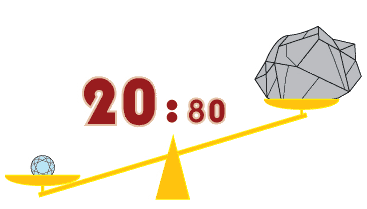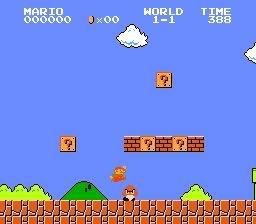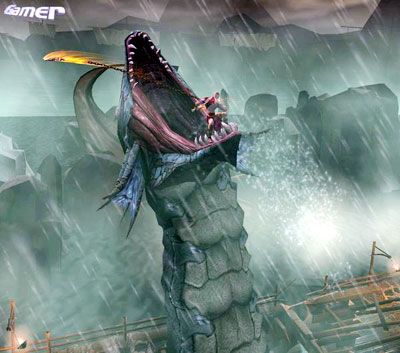
The very beginning of a videogame is arguably the most important part. People are willing to dismiss all the hard work that has been done immediately if the game doesn’t immediately grab them. I know I’ve done it and I’m sure everyone reading this has as well. The true beginning of a game for me starts with the front-end and if that sucks, I’m already not looking forward to the game. However the first ‘level’ is what we are going to concern ourselves with. Some games don’t have levels in the traditional sense but I think what I am going to talk about can still apply in the general sense.
Vilfredo Pareto was an economist who is credited with establishing what is now widely known as the Pareto Principle or 80/20 rule. When he discovered the principle, it established that 80% of the land in Italy was owned by 20% of the population. Later, he discovered that the pareto principle was valid in other parts of his life, such as gardening: 80% of his garden peas were produced by 20% of the peapods.
There are tons of examples of where this holds true if you want to know more. A simple search on google will yield more results then I’m willing to babble about.
For some reason I find this number fascinating and have tried to inject it into game design. I’m sure the number could easily be applied to what games sell – 20% of games amount for 80% of the revenue or whatever, with games like GTA, Madden, etc being part of that 20%. But to be honest that only interests me for about 10 minutes and then I get bored and think about something else.
After I got bored, I started thinking about flipping it around and saying that 80% is necessary and 20% is not. Talking at random with Eric Williams, one of the other combat designers for God of War we both agreed this number has some merit. A rule of thumb that we came up with on God of War for the combat was, “Anything a pro can do a button masher can do but only 80% as well.”
Thinking more about this number and how it could be applied to game design – I noticed something about first levels of games, a good first level involves 80% of what the game is about. By this I mean that in the first level you are going to do 80% of all the things you will be doing in the rest of the game. There are many great examples of first levels that do this but I’m going to talk about 2, mostly because I know these levels inside and out. One from playing so much as a kid and the other from playing so much while working on it.
Super Mario Bros world 1-1
One of the greatest games of all time also happens to have one of the greatest first levels. There are a lot of things that go into making a first level great – artwork, sound, ‘fun’ things to do and being accessible. For the time when this game was released, this level had it all. Play the first few notes to this level and everyone can finish the rest.

I’m sure we all recognize this screenshot as the very beginning of the game. This beginning tells us much of what the game is about: Jump on creatures to kill them and jump and bump your head into blocks. The ones with question marks give out goodies – such as coins and mushrooms which make you grow bigger. The ones without questions marks can be interacted within the game world: small Mario can hit them and big Mario can destroy them. The fact that normal brick blocks can hide goodies is saved for later on in this level.
80% of what this game is about is done in this first level – from discovering how to attack creatures to destroying blocks to finding hidden section and hidden 1ups. The list goes on though: hopefully becoming fiery Mario, becoming invincible, tricky jumps to barely make to completing the level by landing on the flagpole to receive the bonus and maybe some fireworks if you are lucky.
This level does a good job of exposing the player to what the game is truly about while holding on to surprises such as swimming for later on.
God of War – Hydra Level
I was not involved at all with the level design of this game, let alone design for this level. Although I feel weird talking directly about a game I’ve worked on – I feel distant enough from this aspect to discuss it. Plus I played this level so much that I know it intimately enough to write something about it.

The game starts off with you fighting enemies with enough of an opening movie to pique your curiosity. This alone does a really good job of summing up what the game is about! From here you mash on R2 to open up a door teaching the player how to open up doors. Then a quick boss encounter happens where you are taught how to perform mini-game kills with the gigantic button prompts. From there you cross the chasms with balance beams. The player is then quickly introduced with a few more boss encounters, a simple puzzle (the box push puzzle), wall combat, gaining magic, and ending with a boss encounter that includes a puzzle as well. Eighty percent of what is done in God of War is done in this first level.
Conclusion
I’m sure there are plenty of ‘bad’ games where you do 80% of what the game is about in the first level. I think what games such as SMB1 and RE4 do so well during their first level is keep presenting you with new tasks to hold your interest. First levels are really hard to get right and there is no magical formula to making one.
9 comments:
How does this apply to, say, a fighting game, where 100% of the action of the game is contained in the first level?
I would say that a player does not yield 100% of the gist of a fighting game the first time they play it, which is really what your analogy would be, if fit inside the point Derek is making. Sure, you have ready access to everything possible in the game, but the dynamics and intricacies of a fighting game are learned through experience; presumably, more experience than can be yielded in two or three rounds.
Plus, multiplayer games rely on the notion that players will create their own play by dynamically generating more scenarios than the designer envisions - again, something probably not exhausted in a few rounds.
Also, i think modern fighting games do a much better job of showing you that 80% than older ones. I mean, you have to put a lot of cool shit in your game to appeal to your audience. But you also have to make sure that your audience has easy access to enough of that stuff to grab their attention.
Even back in the day when Ryu's fireball and Zangief's Spinning Piledriver were considered visually impressive, it took a long time for players to gain access to them. That's part of what hurts traditional 2D fighting games compared to the flashy new 3D ones. In successful modern fighting games, all the moves are simple button combinations. So if you pick up Tekken and start mashing buttons, your character will do a huge variety of attacks, some of which cause the camera to go crazy. You just kind of feel like you did something special and that experience comes very early on.
I don't think fighting games can utilize the 80/20 principle. It would be unusual for someone to pick up the majority of the moves and strategy in his/her first sitting (unless it's a sequel).
But Derek, a great article nonetheless. The first level of a game is essential to capture the gamer's interest for any subsequent levels.
How many moves does Ryu really have? 6 standing attacks, 6 close standing attacks, 6 jumping attacks, 6 low attacks, 3 special moves, a pair of throws. That's not so much. If you're talking about the moves and strategies that are developed later on, i'm sure you can apply the same objection to any game. Those crazy speedruns of Super Mario Bros that people do nowadays have hella "moves and strategy" that nobody found on day one.
I don't think the 80/20 guideline applies to every usage of every move. To me it seems like Derek is saying that you should make sure the player finds 80% of the major stuff you want to show them on the first level. There's no way to ensure that the player ever finds 80% of everything you can possibly do with the game engine. Most people still don't know 80% of what you can do in Tetris.
- Maj
http://sonichurricane.com
It does apply to fighting games. Because in a game like Super Mario Bros, you discover 80 of what you can do. The applications of what you can do come later. So when you play a fighting game, you find out what all your Normal Moves are, what Special Moves you have, what Supers, etc. And then you'll find the application/strategy stuff later. But that's a difference between WHAT you can do and HOW you can use it. The 80/20 rule still applies: youwill still find out the majority of what you can do, even in a fighting game.
Maybe that's why games like Tekken are so hard for me to get into. Ifeel like it actually takes a lot longer to learn what you can do, since there are soooo many different strings and move combinations compared to a Street Fighter game. The 80/20 rules doesn't apply to them as well.
The 80/20 rule can easily be applied to fighting games like most people on here have already said.
I think what Tekken does a better job than say VF is that you get to see 80% of their 'flash' when you first play the game. VF has no flash so there is no wow factor to be had, let alone a percentage. This is where fighting games like Tekken, Soul Calibur and even Smash Bros really shine - hooking the players with 80% coolness right away.
That's actually a really good point. While Tekken may be harder from an extremely technical standpoint to learn, which is how I approach most fighting games, the majority of the public isn't gonna approach it that way. Getting access to 80 of the flash is MUCH more important for popularity and approachability for the majority of people. And in SF, the flash only fits into "Let's see their Supers!" Outside of that, there is very little flash in a 2-D game anymore.
Really great post, Thank you for sharing This knowledge.Excellently written article, if only all bloggers offered the same level of content as you, the internet would be a much better place. Please keep it up!
Post a Comment